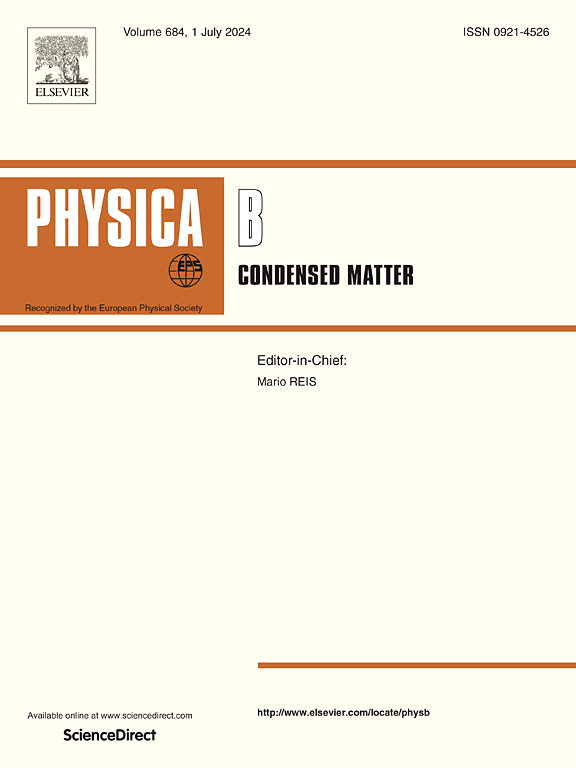MoS2/MoSe2核壳纳米线基态性质的探索:从头计算方法
IF 2.8
3区 物理与天体物理
Q2 PHYSICS, CONDENSED MATTER
引用次数: 0
摘要
我们描述了一种理论和计算方法来评估MoS2/MoSe2核壳异质结构的结构、电子、光学、机械和振动特性。MoS2/MoSe2核壳结构由垂直异质结构和水平异质结构组成。直接带隙能量为1.67 eV。光吸收峰落在UV- c区域内,表明作为UV传感器和探测器的潜在用途。超过87.5%的光被反射,这表明这是一个潜在的良好吸收剂。皮尤的参数表明,这种化合物很脆。负泊松比表明这种材料可能是金属离子电池的潜在阳极。我们还探讨了电子-声子耦合;色散图显示虚频率可以忽略不计。核壳结构是动态稳定的,表明这种材料是可以制造的。上述结果验证了我们的MoS2/MoSe2核壳结构预测。本研究提供了基于纳米线过渡金属二硫族化物异质结构的可靠数据集。本文章由计算机程序翻译,如有差异,请以英文原文为准。
The exploration of ground state properties in a MoS2/MoSe2 core–shell nanowire: An ab initio approach
We describe a theoretical and computational approach to evaluate the structural, electronic, optical, mechanical, and vibrational properties of MoS2/MoSe2 core–shell heterostructure using DFT calculations. The structure of a MoS2/MoSe2 core–shell consists of vertical and horizontal heterostructures. A direct bandgap energy of 1.67 eV has been measured. The peak optical absorption falls within the UV-C region, indicating potential use as UV sensors and detectors. Over 87.5 % of light was reflected, suggesting this is a potential good absorber. Pugh's parameters suggest that the compound is brittle. A negative Poisson's ratio suggests this material may be a potential anode for metal-ion battery cells. We have also explored electron–phonon coupling; the dispersion plot shows negligible imaginary frequencies. The core–shell structure is dynamically stable, suggesting this material can be fabricated. The above result validates our MoS2/MoSe2 core–shell structure prediction. This study provides a reliable dataset based on the nanowire transition metal di-chalcogenide (TMD) heterostructure.
求助全文
通过发布文献求助,成功后即可免费获取论文全文。
去求助
来源期刊

Physica B-condensed Matter
物理-物理:凝聚态物理
CiteScore
4.90
自引率
7.10%
发文量
703
审稿时长
44 days
期刊介绍:
Physica B: Condensed Matter comprises all condensed matter and material physics that involve theoretical, computational and experimental work.
Papers should contain further developments and a proper discussion on the physics of experimental or theoretical results in one of the following areas:
-Magnetism
-Materials physics
-Nanostructures and nanomaterials
-Optics and optical materials
-Quantum materials
-Semiconductors
-Strongly correlated systems
-Superconductivity
-Surfaces and interfaces
 求助内容:
求助内容: 应助结果提醒方式:
应助结果提醒方式:


